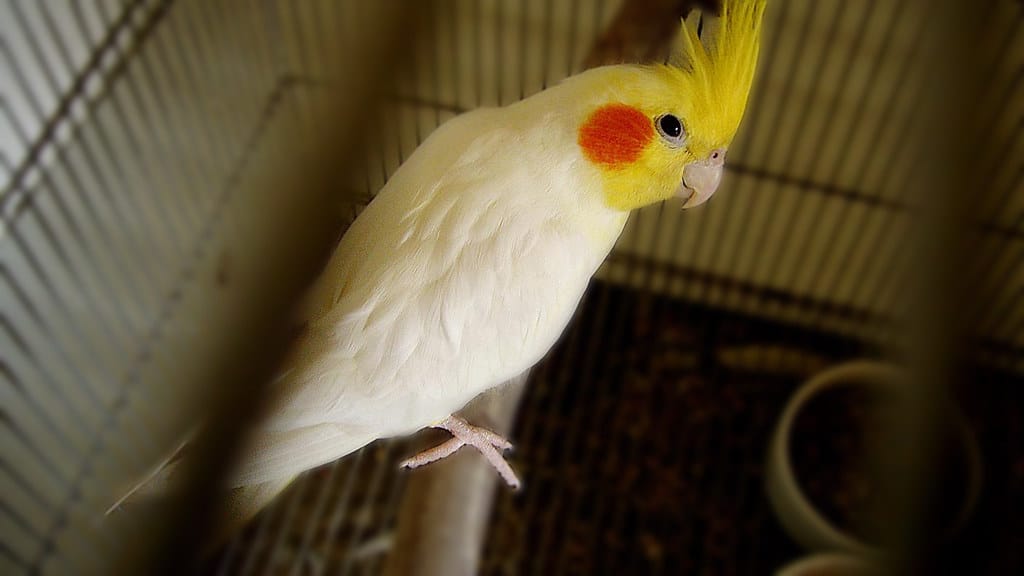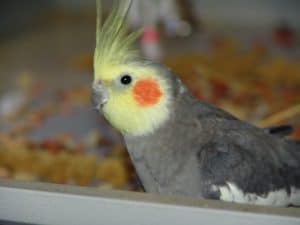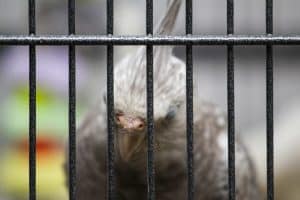This article aims to provide an overview of the talking ability of cockatiels, including factors that influence their vocalization, tips for training cockatiels talk, and the types of sounds they are most likely to mimic words.
Cockatiels are a popular pet bird species known for their playful and affectionate personalities. One of the fascinating aspects of these pet birds is their ability to mimic sounds and learn to talk. Many bird enthusiasts are curious about whether cockatiels talk, and if so, how well they can do it. In this context, it is worth exploring the fascinating world of cockatiel communication to understand how these birds communicate and what factors may influence cockatiels talk.
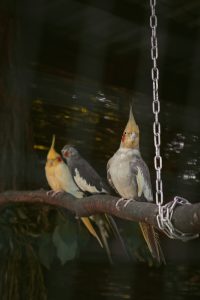
Can Cockatiels Talk?
Yes, cockatiels have the ability to mimic cockatiel sounds and learn to talk. However, not all cockatiels talk, and some may be more inclined to whistle or imitate sounds instead. Cockatiels can also learn to whistle tunes and mimic environmental sounds, such as phone rings and alarms. It’s important to note that not all cockatiels talk, will develop a large vocabulary, and the ability to talk may vary from bird to bird. Additionally, it’s important to provide a stimulating environment and spend time interacting with your cockatiel to encourage cockatiels talk and develop their communication skills.
Can Female Cockatiels Talk?
Yes, female cockatiels have the ability to talk just like male cockatiels. Both male and female cockatiels have a vocalization system that allows them to mimic sounds and learn to talk. However, just like with male cockatiels, not all female cockatiels will talk, and some may be more inclined to whistle or mimic other sounds instead.
The ability to talk is not determined by the sex of the bird but can depend on various factors, including the bird’s individual personality, the amount of socialization and training they receive, and the age at which they are exposed to language. Some cockatiels may be more talkative than others, regardless of their gender.
It’s worth noting that female cockatiels may have a softer and higher-pitched voice compared to male cockatiels. This may affect the clarity and tone of their words, but it does not impact their ability to learn and mimic sounds. With proper training and socialization, female cockatiels can develop a robust vocabulary and communicate with their owners in a variety of ways.
When Do Cockatiels Start Talking?
Cockatiels are known for their ability to mimic sounds and some can learn to talk, although not all of them do. The age at which a cockatiel starts talking can vary, and some may never learn to talk at all.
Generally, cockatiels begin to mimic sounds around 3 to 6 months of age, although some may start earlier or later. However, it may take several months or even a year or more for a cockatiel to develop a vocabulary of recognizable words or phrases.
It’s important to note that not all cockatiels are able to learn to talk, and even those that do may only learn a few words or phrases. Additionally, males are more likely to talk than females, although this is not a hard and fast rule. The amount of time and effort spent in training your cockatiel can also play a significant role in its ability to learn to talk.
How to Teach Your Cockatiel to Talk?
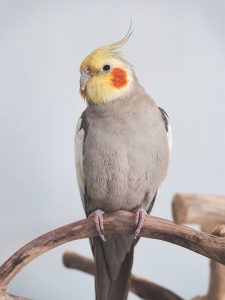
If you’ve never taught words or music to a bird before, the suggestions below will help. Start practicing with your ‘tiel(s) while wearing your patience cap!
Before you begin training of cockatiels talk, be certain that your bird is in good health and feels at ease with your presence.
Pick your phrases
When selecting a phrase or song to teach your cockatiel, keep in mind that it must be brief. They’re not good at lengthy and complex talks.
When it comes to speaking, you don’t want to use words that the bird doesn’t understand. Things like “hi-hi!” when approaching the cage and “bye-bye” when leaving work are fine. Simple things such as “hi bird,” “beautiful bird,” or the cockatiel’s name are best.
If you’d want to play a tune for your parrot, make sure it’s not too complicated. Consider the lyrics to “if you’re happy and you know it”: just a few distinct tones that you can easily whistle to your bird or loop. If you want to know how much your cat loves you, just ask him! Make sure it’s not too annoying since they’ll be hearing it a lot! It’s easier for a bird to whistle than speak, so it might pick up tunes faster than words.
Tip: Remember that your cockatiel won’t be able to recall many of the songs and phrases you teach it, so don’t overthink it! If you do, it’s possible that it will cease repeating some of them or start creating its own mixes using its favorite music.
Female cockatiels are not strong talkers like the male cockatiel are, but you can try!
Training
- Repetition is the key to getting your cockatiels to take. I mean, until you’re ready to blow a gasket in your own head! You should talk and whistle to your cockatiel, repeat words, same words when you’re near the cage so that it becomes familiar with human sounds.
- Positive association is when your cockatiel learns that the sound of your voice and the words you choose are associated with pleasant times, making it easier for him to imitate sounds. This is called positive association, and it’s how you should go about teaching cockatiel sounds. When learning new skills, they won’t respond to negative reinforcement or punishment.
- Take your parrot out of its cage for 10-15 minute talking/training sessions one or more times a day, in addition to talking cockatiel all day every day. Sit down and talk to the bird in a loud voice while giving it some head scratches. If the bird cockatiels start talking, mimic words, give it something delicious right.
- If your bird doesn’t seem to be comprehending a certain word, it could dislike it or have difficulty saying it. Try switching to something simpler.
- When you gently shake the bird up and down or side to side while it’s perched on your hand, speak to it at the same time, it will be enthused. Some cockatiels adore singing to anything, and not just something that makes sense. It may actually enjoy serenading your foot, a crumpled tissue or even food. It might also need a leaf of spinach on its head to get in the singing mood.
- Parrot Essential Toy: The bird parrot toy provides essential physical activity to keep your feather friends stable and happy, and improve your health. There are several multi-colored blocks in this single toy to entice your bird. These blocks are arranged in multiple layers to climb and explore.Birds also love to untie cotton rope knots, which satiates their natural urge to chew.
- Safe To Chew: Our wood parrot toys are made of pure natual wood & cotton rope, all of them are dyed by edible pigments, and completed with pure handmade which are more bite resistand and durable.
- Perfect Size: The size is 13.78" X 5.12". perfect size for small and medium birds. It is suggested for african greys, budgies, parakeets, cockatiels, conures, lovebirds and other similar sized birds. Provide your bird an ideal elevated place to chew and climb.
- Beak Trimmed: Parrot's beak keeps growing to keep sharp. if her beak is long can affect the ability of the parrot to eat and damage her health. Our parrot chew toys contain colored wooden blocks and other accessories in various shapes to attract your parrot to chew, help your feather friends to preen and condition their beak.
- Best Gifts For Your Parrot: It is designed in bright color, which can easily attract parrots attention in short time and they will play with these toys for long time daily, keep your parrots busy, less destructive and have more fun hours.
Tip: You can record yourself reciting your favorite phrases like pretty bird and play the recording to your bird throughout the day. There are also YouTube videos dedicated to teaching parrots how to talk. Personal interaction is more effective in terms of building a positive association, so keep that in mind when training your parrot.

The Cockatiel Contact Call: “Where’d you go?!”
With contact calls, a pet cockatiel will generally attempt to keep household members’ movements in check. When you depart the area, your cockatiel talking lets out a chirp or series of chirps, as though to ask, “Where are you going and when will you return?” Talking cockatiel may also contact call when they are not connected to a person they are close to. Even if you leave the room while your cockatiel is perched in its cage, it will send out a contact call from its perch location. When you turn a corner away from its view, cockatiels start talking with a quick whistle.
Cockatiel Flock Call
Cockatiels are social birds that communicate with each other through various vocalizations, including their flock call. The flock call is a distinctive chirping sound that is used to keep the members of the flock together and maintain social bonds. It’s a high-pitched, melodic sound that can be heard throughout the day, particularly in the morning and evening when cockatiels are most active.
The flock call of cockatiels is unique to each flock, and birds can recognize the calls of their flock mates. The call is used to convey a range of emotions and messages, including greetings, warnings of danger, and signals of food sources. For instance, a loud and repeated flock call can indicate that a bird has found a new source of food, prompting other birds to come and join in.
When kept as pets, cockatiels may still use their flock call to communicate with their owners and other pet birds in the household. It’s important to understand the meaning of these vocalizations to better understand your pet’s needs and emotions. Additionally, mimicking the flock call can help strengthen the bond between a cockatiel and its owner.
Cockatiels Singing and Talking Conclusion
Cockatiels are known for their vocal abilities, which include singing, whistling, and even talking. Some cockatiels may have a natural inclination to mimic sounds, while others may need more encouragement and training to learn to talk.
When it comes to singing, male cockatiels are particularly known for their melodious tunes. They often sing to attract a mate or to communicate with other birds in their flock. Singing is a natural behavior for cockatiels and can bring them joy and entertainment.
Talking, on the other hand, is a learned behavior that not all cockatiels will master. However, with patience and persistence, many cockatiels can learn to mimic words and phrases. Some popular phrases that cockatiels may learn include their own name, “hello”, “goodbye”, and “pretty bird”.
If you want to encourage your cockatiel to talk or sing, try talking to them frequently, using a high-pitched, sing-song voice. You can also play music or sing to them to encourage them to start vocalizing. With time and patience, your cockatiel may surprise you with its vocal abilities.
For more valuable insights and tips on cockatiel care and related topics, be sure to read our other informative articles. Find out if leeks are a safe addition to your bird’s diet in Can Cockatiels Eat Leeks?. If you’re curious about kidney beans, learn whether they are suitable for your cockatiel by checking out Can Cockatiels Eat Kidney Beans?. Ensure a safe environment for your pet by exploring Are Paint Fumes Bad for Cockatiels?. For a unique perspective on health, delve into Chocolate and Dental Health. Lastly, gain a better understanding of cockatiel behaviors by reading Why Does a Cockatiel Stand on One Leg?. Each of these articles is packed with valuable information to help you ensure your cockatiel’s health and happiness.
